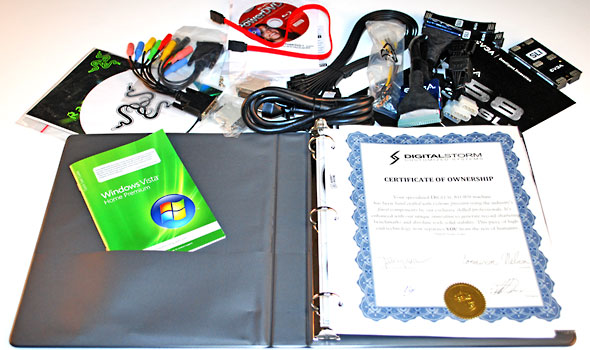Digital Storm Custom Core i7 Gaming System
Interior Layout, Components, Build and Bundle

Admittedly, we're a bit partial to the TJ series of Silverstone cases, so Digital Storm had already established a good foundation from which to build the machine. From there, with the right component selection and a reasonable effort in proper cable management, routing and tie-off techniques, a super-clean and reliable design is very achievable.




As you can clearly see in these shots above, once the side panels are off you are met with an impeccable layout as well as cool, efficient cable routing that takes advantage of the available area behind the motherboard tray. As such, airflow within the case itself is quite good.








Cooling, Overclocking, Audio and Power:
The CPU cooler that Digital Storm chose to keep this rather vigorously overclocked machine stable, is the CoolerMaster V8. On the top of this fansink cooler is Digital Storm’s logo but beyond that it’s a stock off-the-shelf assembly. This cooler does a nice job of keeping thermals in check, but it is a bit on the noisy side in our opinion, when the fan is dialed up to its maximum speed. We found that the machine’s Core i7 920 overclocked to 3.79GHz ran at 62 - 70ºC under full load at the slowest CPU fan speed setting (712RPM) and idled at around 38ºC. At the V8 cooler's max fan speed of 1K RPM (which again was a bit loud for our taste), full load temp at all four cores dropped to 60ºC - 66ºC range, which was much more palatable. Note that the fan speed of the V8 cooler is virtually infinitely adjustable via its dial potentiometer-based control that is mounted on the backside card slot panel of the case. So you could find a happy medium somewhere along the way between acoustics and the max CPU temp that you're willing to live with.
Corsair’s excellent HX1000W series power supply is providing the juice for this muscle rig and it has more than enough available amperage for the build-out we tested in addition to offering a ton of headroom for expansion. You could easily add another GeForce GTX 285 graphics card to the machine and still have plenty of available power for the factory-set overclock on the CPU, along with the added load of the second graphics engine.
In addition, this PSU’s modular cable design allows for future expansion with only the cable you’d need to power that specific new component being installed. However, we would encourage the folks at Digital Storm to include the PSU’s extra cable connectors as they weren’t included in the kit that arrived to our labs for testing.
Lastly, for a better gaming audio experience, Digital Storm dropped in the Razer Barracuda AC-1 PCI audio card, which has been well-received in the press and the community at large. We found the card offered solid reproduction and response characteristics, though this product is definitely targeted more toward the gamer, versus the audiophile.

Pictured above is the bundle we received from Digital Storm for the system. Beyond the missing extra PSU cables, all, motherboard, audio and graphics card accessories are provided, in addition to SLI and 3-Way SLI bridge connectors. Noticed also Digital Storm's Certificate of Ownership, where multiple QA signatures were signed-off before the system shipped from the factory.
The CPU cooler that Digital Storm chose to keep this rather vigorously overclocked machine stable, is the CoolerMaster V8. On the top of this fansink cooler is Digital Storm’s logo but beyond that it’s a stock off-the-shelf assembly. This cooler does a nice job of keeping thermals in check, but it is a bit on the noisy side in our opinion, when the fan is dialed up to its maximum speed. We found that the machine’s Core i7 920 overclocked to 3.79GHz ran at 62 - 70ºC under full load at the slowest CPU fan speed setting (712RPM) and idled at around 38ºC. At the V8 cooler's max fan speed of 1K RPM (which again was a bit loud for our taste), full load temp at all four cores dropped to 60ºC - 66ºC range, which was much more palatable. Note that the fan speed of the V8 cooler is virtually infinitely adjustable via its dial potentiometer-based control that is mounted on the backside card slot panel of the case. So you could find a happy medium somewhere along the way between acoustics and the max CPU temp that you're willing to live with.
Corsair’s excellent HX1000W series power supply is providing the juice for this muscle rig and it has more than enough available amperage for the build-out we tested in addition to offering a ton of headroom for expansion. You could easily add another GeForce GTX 285 graphics card to the machine and still have plenty of available power for the factory-set overclock on the CPU, along with the added load of the second graphics engine.
In addition, this PSU’s modular cable design allows for future expansion with only the cable you’d need to power that specific new component being installed. However, we would encourage the folks at Digital Storm to include the PSU’s extra cable connectors as they weren’t included in the kit that arrived to our labs for testing.
Lastly, for a better gaming audio experience, Digital Storm dropped in the Razer Barracuda AC-1 PCI audio card, which has been well-received in the press and the community at large. We found the card offered solid reproduction and response characteristics, though this product is definitely targeted more toward the gamer, versus the audiophile.

Pictured above is the bundle we received from Digital Storm for the system. Beyond the missing extra PSU cables, all, motherboard, audio and graphics card accessories are provided, in addition to SLI and 3-Way SLI bridge connectors. Noticed also Digital Storm's Certificate of Ownership, where multiple QA signatures were signed-off before the system shipped from the factory.






